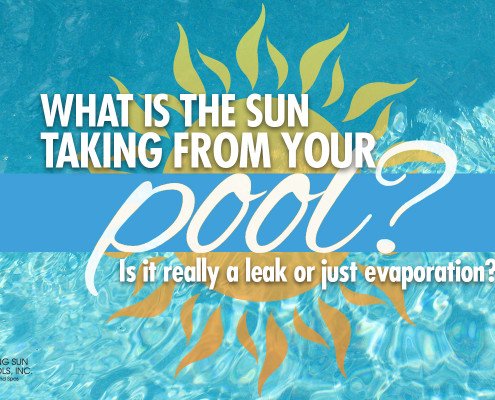How Much Water Should My Pool Lose?
Water loss is a constant part of any pool owner’s summer, but what causes your pool to lose water and how can you tell if you’re losing normal amounts of water or if you have a leak? Below are answers to common questions and a quick experiment to test for a leak.
WHY IS MY POOL LOSING WATER?
All pools will lose water throughout the summer for a number of reasons including:
- Normal Pool Use – normal splashing and playing will account for some amount of water loss as water washes over the edges of your pool
- Evaporation – Natural processes cause water to leave your pool daily
- Possible Leaks in you pool equipment – a leak in any part of your pool, from the bowl to the pump, could account for water loss in your pool
HOW MUCH WATER SHOULD I LOSE TO EVAPORATION?
Evaporation is a natural process that puts water back into the air. Ponds, puddles on the road, and even your pool go through the process of evaporation. A number of things can affect how much water is taken from your pool by evaporation such as high winds, humidity and the daily temperature. North Carolina with its hot, humid summers has relatively low evaporation rates for pools unless we get a very hot day and a very cool night back to back which can increase evaporation rates. So how much should you be losing? On the extreme end, a pool can lose as much as a quarter-inch of water per day! But each pool’s rate will differ. Luckily, there is an easy test for how much water you’ll be losing due to evaporation: the bucket test. All you need is a bucket and some duct tape:
- For the duration of the test you will need to stop adding water to your pool, so turn off any “autofill” devices and stop manually adding water to the pool.
- You also don’t want to splash water out of the pool during the test, so perform the bucket test when you know your pool will have at least 24 hours without anyone swimming in it.
- To start the test, place an empty bucket on one of the steps of your pool, but not completely submerged. The top or second step is usually the best location.
- Fill the bucket with water so that the water level inside the bucket and outside the bucket are the same
- Mark the water level on the bucket with a piece of duct tape, sharpie or wax pen.
- Wait at least 24 hours for evaporation to occur, 2-3 days is best but you can see results with shorter time periods
If when you go back to check your bucket, the water levels are still the same (i.e., the pool and the bucket lost the same amount of water), then your pool is fine! If your pool has lost significantly more water than the bucket, you may have a leak. Request service and one of our talented representatives will help you begin repairs! Photo Credit: Lars Ploughmann

